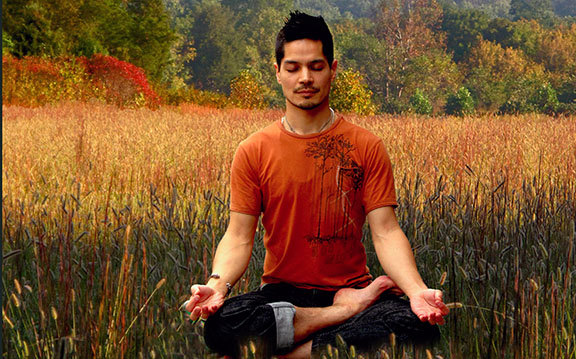 It may seem that some people are natural born yogis and that spiritual practice comes easily to them. Are there certain qualities that we see in people who have a well-grounded sadhana? The answer is yes, but they rarely appear full blown in anyone. They need to be developed. They are already within us, but they need to be nurtured to find full expression.There are six characteristics to explore: fervor, humility, generosity, fidelity, creativity, and patience. These qualities are found in successful people in all fields of endeavor. These are qualities that we admire in our role models. Let them serve as an invitation to become the hero of your own life.
It may seem that some people are natural born yogis and that spiritual practice comes easily to them. Are there certain qualities that we see in people who have a well-grounded sadhana? The answer is yes, but they rarely appear full blown in anyone. They need to be developed. They are already within us, but they need to be nurtured to find full expression.There are six characteristics to explore: fervor, humility, generosity, fidelity, creativity, and patience. These qualities are found in successful people in all fields of endeavor. These are qualities that we admire in our role models. Let them serve as an invitation to become the hero of your own life.
Fervor
Fervor is a constant longing for a goal we have set before ourselves. It is born from a sense of not being fully at home, at rest or whole until our goals are reached. We experience a kind of fervor when we are separated from our beloved for an extended time. Our thoughts go again and again to our loved one. We can’t shake the feeling that something vital is missing, that we are not whole. Contemplating this simple formula can generate fervor in sadhana: Life, sooner or later, brings suffering. Sadhana offers a way to transcend suffering
The ultimate goal of Yoga sadhana is realization of our true nature. It is the only experience that can douse the flames of suffering. The one thing we cherish most—our happiness—cannot be given, fully or permanently, by anything else. It may be a little unsettling to contemplate the fact that nothing else can give us the peace and happiness we seek. Even the glories of nature or the comfort, warmth, love and security of family life cannot fulfill this need for a state of happiness so deep and unshakable that it dissolves all sorrow.
Try this exercise: Write down ten things that define who you are. Reflect carefully. Think of those things that are the nearest and dearest to you: the most vital, those things that define who you are, such as your spouse, sense of humor, intellect, ability to make friends or reasoning power. Once you’re satisfied with your list, cross off the two least important. Think carefully before you cross off anything. You can’t get them back. They are being erased from your life. Now cross off two more, then two more. Keep going until all are scratched out. Then realize this: All of us will experience the pain of losing everything on our lists one day or other. It’s not a pleasant exercise. But there’s a bright side: sadhana can be the vital center-point of a life that frees you from this pain. No one and nothing can ever take your Self from you. It is in you, is you, and is eternally free from all suffering. Fervor is a force that brings ignorance to the brink of extinction.
Fervor doesn’t mean that you become a recluse or an off-balanced obsessive fanatic. One of the beautiful things about being a yogi is that most people don’t even have to know about your sadhana practice. You quietly go about your life, doing your daily sadhana. The special serenity that you radiate may be the only thing that gives you away.
Humility
One of the main problems with finding success in sadhana is that we can’t fully accept the power that lies in its simplicity. We are conditioned to believe that solutions to problems will come from advanced science and technology, or from experts who have mastered principles beyond our understanding. How can sitting with our attention focused on the breath, an image or sound transform our lives? Shouldn’t the solution to erasing suffering be more complex? The challenge is to be humble enough to accept the simplicity of Yoga and meditation and being willing to surrender to the practice.
Intimately connected to humility is the tantalizing capacity to be wonderstruck. It is a state of mind that revels in learning, in being surprised by life and truth. It regards the unknown, not with terror, but with interest, objectivity and openness. We know that when one is struck with wonder, words fall away. The mind becomes still and alert. The breath may stop, hence the word, “breathtaking.” We are left with wonder. The mind cannot grasp the experience in its entirety, but it doesn’t matter. We surrender to the experience. That’s part of its joy. The experience of wonder is a taste of the transcendent. It is an experience that brings with it the knowledge that every moment contains infinite possibilities. Possibilities carry with them hope and optimism.
Generosity

Generosity means to put aside desires that are limited to personal benefit in order to create a greater, more fulfilling reality. Generosity knows that nothing is lost by selfless giving. There is only gain. Generosity is a companion of compassion. We are born with an instinctive impulse to alleviate suffering, but that inclination is often blocked by suspicion, fear and personal cravings.
Generosity means more than donating to worthwhile causes. When we devote our time and energy to listen to the problems of others, allow someone with only one item to move ahead of us at the market or rejoice in the happiness of others, we are exercising generosity.
Sadhana requires a generous spirit: giving of our time and effort. It’s not really different from devoting our time and resources for a greater good. In meditation we put aside what the mind wants in order to pay attention to the object of meditation. Practicing generosity in life will lead to better meditation. Conversely, meditation will naturally lead to greater generosity in daily life. Sadhana is worthy of our time and attention. It brings benefits to those around you and to you.
Fidelity
This virtue is the backbone of success in sadhana and in any endeavor. Fidelity is continued loyalty to a person, cause or belief. It expresses as steadiness, integrity, strength and dependability, sticking to a goal and keeping our word. People who have developed fidelity have the patience, openness of heart and the courage to stay with a task to its completion. Fidelity to sadhana can transform your mind and your life. Old habits are very stubborn and resist change.
To understand why this is so, we should discuss how habits are formed. Think of the mind as being a lump of clay. A thought, as it moves across the mind, is like a pin scratching a path across a soft surface. Repeated thoughts cut through the same path and create deep grooves. The grooves create pathways along which prana, and our attention, flows. Habits are difficult to change because our mental energy tends to fall into the deepest grooves. When we begin our practice, the sadhana grooves are not very deep. With repetition, these new grooves will get deeper. Meanwhile, like unused jungle trails overgrown with plant life, old unwanted grooves begin to fill in. Old habits, their strength now diminished, will fade while new ones become strong. Over time, the new habits become so deeply ingrained that they become part of our character. The highest benefits of sadhana cannot be realized without sadhana becoming a deeply ingrained habit.
The following are some suggestions to help you cultivate fidelity:
- Carefully set realistic goals and follow through. Use this principle in all aspects of your life. Finish the book you’ve chosen to read, go to the dinner party you may dread, complete the continuing education course on knitting even though the teacher bores you. There is no greater virtue than having your actions in alignment with your thoughts and words.
- When you give your word, keep it. It’s not easy. Think twice before speaking.
- Digging shallow wells won’t give you water. Don’t scatter your energy by flirting with commitments. Frequent changing of goals doesn’t yield much fruit. You won’t make the best and quickest progress in sadhana by taking a little here and there from different schools of thought. That can lead to confusion as well as dissipation of your energy. Superficially, Yoga and meditation styles are different, but in essence, they are one. You might miss their depth by dabbling. Go deep and experience the core. Another benefit of sticking to one thing is that you develop the capacity to prevent obstacles in sadhana. The mind becomes so steady, clear and one-pointed that you don’t have to exert much energy overcoming obstacles. Like water off a duck’s back, they naturally roll off such a mind.
- Analyze your desire for change. Carefully and patiently ask yourself why you want to look for another job, relationship or Yoga school. Sometimes, there are good reasons, especially if it means protecting yourself from harm. Much of the time, however, it is the mind being restless or resisting change, even positive change.
- Don’t become obsessed with quick results. Nothing great was ever accomplished overnight. Tend to the process; the results will take care of themselves.
- Make use of group support. Associate with others who share your goal.
- Don’t set yourself up for failure. Be honest with yourself. Set goals in which you truly believe. Don’t do things just because they are popular, or your friends encourage you to do them. If you do, you’ll lack the earnest zeal needed to succeed. Even with Yoga, if sadhana is not for you at this time, why punish yourself with it? Maybe you will be drawn to it later.
- Create a consistent practice. While it’s certainly fine to experience other techniques from time to time in order to expand your understanding of Yoga, your daily routine should be stable. Not rigid, stable. The length and content of your sadhana will evolve over time as you learn and experience more. What doesn’t work well is to make frequent and/or haphazard changes. Success belongs to those whose focus doesn’t become scattered.
- Make sure that the head and the heart agree. Your heart should experience an attraction, an exhilaration and a palpable sense of optimism with your path. At the same time, the mind should approve.
- Have faith in your path. It helps a lot if your spiritual path has a long, distinguished history. The practice of meditation involves many subtleties. A tradition that has proven itself over time is invaluable. You will enjoy the benefits of having a well tread, clearly marked path. This will also provide a context that will help integrate the changes that sadhana
Suggesting this does not imply that every valid path will be a simple repetition of every aspect of that tradition. It can be healthy for a lineage to re-package its teachings for its time and place. It helps keep them alive and relevant. The way teachings are expressed may or may not change, but the essence is always the same.
Cultivating fidelity brings challenges. The mind will present all sorts of reasons to skip a meditation session or give up sadhana altogether. Be prepared: You will experience doubts, lapses and restlessness. If you act only according to how you feel, you’ll miss a lot of sadhana and lose a lot of the benefits. Keep in mind that, because something is difficult, it doesn’t mean that it’s wrong for you. The mind resists going outside its comfort zone. If you’ve investigated the pros and cons of your decision well, stick to it.
Creativity
 Creativity is an essential quality for anyone who wants to live a fulfilling life. Creativity is practical. It is one of the foundations of problem solving. For example, creativity is central to how we deal with our children when they get into mischief. It also comes into play when we try to live within our financial means when inflation outruns our income, when we have an unexpected illness or lose a job. With this in mind, we can see at least one way that meditation exercises creativity. In trying to be regular in our practice, we encounter difficult puzzles to solve: How do I take care of my partner, the dogs and pay the bills, and at the same time, tend to my sadhana? What ways can I think of to make it possible for me to be regular in my practice?
Creativity is an essential quality for anyone who wants to live a fulfilling life. Creativity is practical. It is one of the foundations of problem solving. For example, creativity is central to how we deal with our children when they get into mischief. It also comes into play when we try to live within our financial means when inflation outruns our income, when we have an unexpected illness or lose a job. With this in mind, we can see at least one way that meditation exercises creativity. In trying to be regular in our practice, we encounter difficult puzzles to solve: How do I take care of my partner, the dogs and pay the bills, and at the same time, tend to my sadhana? What ways can I think of to make it possible for me to be regular in my practice?
Successful practitioners are as creative as a Picasso or Mozart. They have had to overcome obstacles from within and without. They have faced every excuse the mind can conjure in order to keep the body in bed in the morning. They have encountered disappointment, set backs and doubt, and found ways to persevere. Through it all, they have managed to find joy and freedom in regular practice. If that’s not creativity, what is?
Creativity requires freedom. Creativity cannot flourish if it’s bound by blind convention or tradition, but it doesn’t abandon either. It’s a state of mind free to imagine what might be. It can envision people and objects in diverse contexts and exhibiting different behaviors. Creativity harnesses the powers of imagination and hope in order to manifest a better reality. Creativity cannot survive without courage. The fear of failure smothers creative impulses. Let the mind soar. Let it conjure—at least for a few moments—realities that could exist. Practicality can come later. Find inspiration from master musicians, athletes, dancers, cooks and entrepreneurs. Take in beautiful music, painting, sculpture, prose and poetry to open the nonverbal, creative aspects of the mind. Creativity and resourcefulness are inborn. They just need to be exercised.
Patience
Patience is not just an exercise in waiting and doing nothing until something happens. Patience is preparation, the marshaling of inner resources. Patience is alert, receptive awareness poised to respond. Each and every sadhana session brings benefit. Those benefits, like seeds that do much of their essential work underground, may remain unseen until later. Fixating daily on results can become an obstacle. Know where you are headed, but focus on the process, not the goal. You will reach your objective more quickly. Learn to value and appreciate every step of the journey. Soon you will find that the fruits of sadhana are not only often different—but they are greater—than you have imagined.
About the Author:

Rev. Jaganath Carrera
Reverend Jaganath Carrera is an Integral Yoga Minister and the founder/spiritual head of Yoga Life Society. He is a direct disciple of world renowned Yoga master and leader in the interfaith movement, Sri Swami Satchidananda—the founder and spiritual guide of Satchidananda Ashram–Yogaville and Integral Yoga International. Rev. Jaganath has taught at universities, prisons, Yoga centers, and interfaith programs both in the USA and abroad. He was a principal instructor of both Hatha and Raja Yoga for the Integral Yoga Teacher Training Certification Programs for over twenty years and co-wrote the training manual used for that course. He established the Integral Yoga Ministry and developed the highly regarded Integral Yoga Meditation and Raja Yoga Teacher Training Certification programs. He served for eight years as chief administrator of Satchidananda Ashram–Yogaville and founded the Integral Yoga Institute of New Brunswick, NJ. He is also a spiritual advisor and visiting lecturer on Hinduism for the One Spirit Seminary in New York City. Reverend Jaganath is the author of Inside the Yoga Sutras: A Sourcebook for the Study and Practice of Patanjali’s Yoga Sutras, published by Integral Yoga Publications. His latest book, Inside Patanjali’s Words, is widely available.

